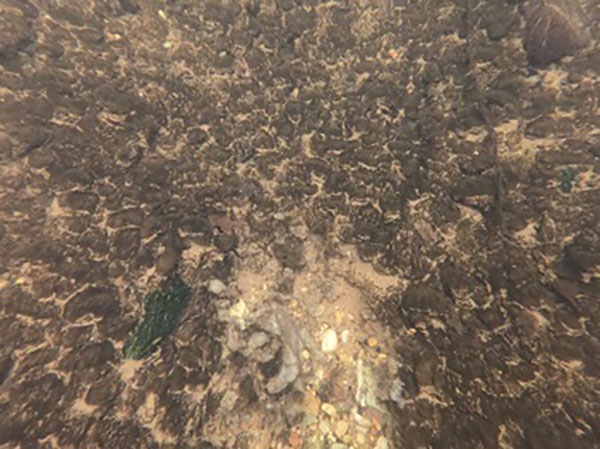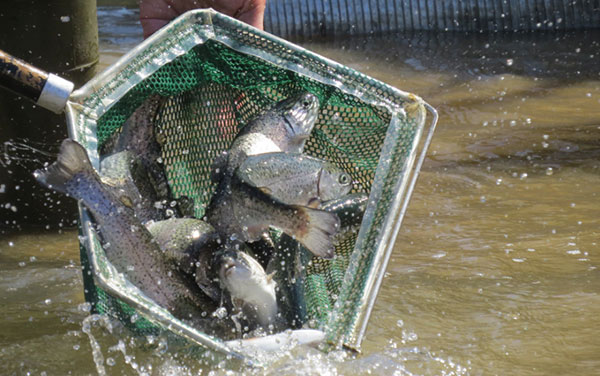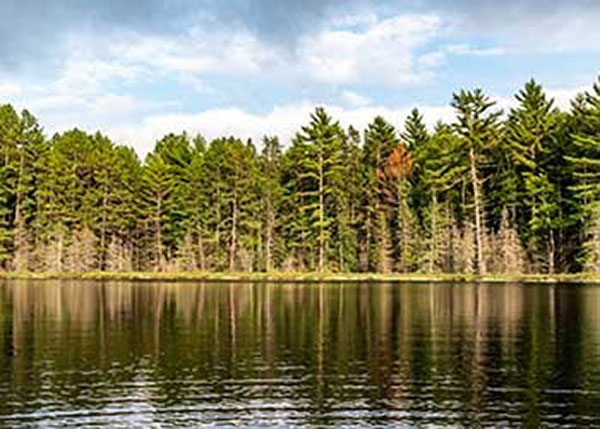- Details
Michigan DNR Report
The flies are tied and rods and waders are ready as the April 29 statewide trout opener approaches.
Before heading out to that favorite fishing spot this season, the departments of Natural Resources and Environment, Great Lakes, and Energy are asking anglers to prepare for one more thing: decontamination.
Michigan’s trout streams are under increasing threat from harmful species that affect habitat and food sources for trout and other fish. Both didymo (rock snot) and New Zealand mudsnail can be moved to new locations on waders, nets and gear.
Didymo
 Didymo
Didymo
Didymo is a microscopic diatom (single-celled alga) that thrives in cold, low-nutrient streams generally considered pristine. Under the right conditions, prolific growth, or blooms, result in thick mats that can cover river and stream bottoms, reducing habitat for macroinvertebrates including mayfly and caddisfly nymphs, which are important food for fish.
- Details
IDNR Report
 Indiana Trout Stocking
Indiana Trout Stocking
The Indiana DNR is stocking nearly 50,000 trout across the state this spring in preparation for trout fishing season. Thirty-three bodies of water across 21 counties will be stocked before opening day of trout season, which is Saturday, April 29.
Lake stockings of rainbow trout started the week of March 20. Anglers do not have to wait for opening day of stream trout fishing season to fish for these aggressive biters because trout fishing on lakes is open all year.
- Details
By Louie Stout
The Indiana DNR is seeking angler feedback as they put together a chinook salmon management plan.
Surveys are being emailed to everyone who bought a license online last year and all anglers are urged to participate.
“We’re looking for public input about our chinook salmon stocking,” says DNR Lake Michigan Biologist Ben Dickinson. “The survey will cover angling habits and ask questions about the various management options the DNR is offering.”
Anglers who didn’t buy their license online or didn’t receive an invitation through email may take the survey by using a generic link: bit.ly/chinooksalmonstockingsurvey.
- Details
By JOHN BAUMAN, Michigan DNR
 Trout lake
Trout lake
The Michigan DNR manages many inland lakes in the Upper Peninsula for brook, brown and rainbow trout.
These trout lakes - less than 100 acres each - are often considered small compared with other inland lakes.
Depending on the lake, various regulations are in effect for anglers hoping to catch trout. In some of these lakes, anglers are restricted to the use of only artificial lures or all tackle is permitted, except minnows. On other lakes, all tackle is allowed.
Again, depending on the lake - designated by letters A through D in the Michigan Fishing Guide - there are minimum size limits for trout, ranging between 8 and 15 inches. There are also seasonal restrictions on some lakes, while others are open year- round.
These regulation variations provide anglers with diverse fishing opportunities.
"Many of these small inland lakes are also remote and provide an exceptional wilderness experience," said Darren Kramer, a DNR fisheries biologist in Escanaba. "For example, a series of remote wilderness lakes located in Alger County have been managed for brook trout since the 1950s."
- Details
IDNR Report
The Indiana DNR is holding two public meetings in January to discuss the current Lake Michigan Chinook salmon stocking plan.
The first meeting will be held on Friday, Jan. 6 at 7 p.m. at the Michigan City Fish and Game Club, 3091 E Michigan Blvd., Trail Creek, IN 46360.
The second is Saturday, Jan. 7 at 10 a.m. at the Indiana Harbor Yacht Club, 3301 Aldis Ave., East Chicago, IN 46312.
Indiana DNR recently announced that 275,000 Chinook salmon will be stocked in Lake Michigan annually starting in 2023, an increase from 225,000.
During the meetings, Indiana DNR will also announce details of a plan for soliciting public input regarding future plans for the species.
“We have a lot of dedicated and informed anglers, and we’d like to get their thoughts to help shape future stocking plans for 2023 and beyond to create the fishery that works best for all Hoosier anglers,” said the agency’s Lake Michigan biologist, Ben Dickinson.
For more information about Lake Michigan fishing visit wildlife.IN.gov/3625.htm.





